TUESDAY
MAY 31 - 2016
Garden
Blackbird
Patrick Murphy
sent a snap of the female Blackbird sitting on her
nest in his back garden for a second brood and clearly
keeping a beady eye on him as he took the photo.
Patrick will keep us posted and hopes to include photo
of young from first brood.
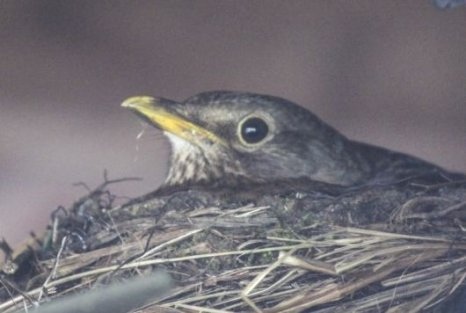
Portsdown
Columbines
Ralph Hollins
has provided a definitive answer to my question posed
in last night's blog as to whether the Columbines I
saw flowering on the lower slopes of Portsdown Hill
yesterday were natives. Clearly not!
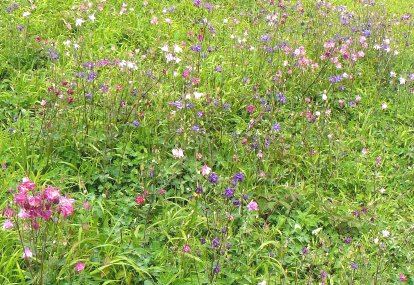
Ralph refers to the
Flora of Hampshire where there is an entry for
Aquilegia vulgaris (ie Columbine) on page 104 which
gives only four sites for the native plants in VC 11.
These are Bratley Water west of Lyndhurst; Granville
Copse near Hambledon; Coulters Dean east of the QE
Country Park; and Bottom Copse at Exton in the Meon
Valley. Ralph also thinks that the native Columbines
only have blue flowers and are only found in mature
woodland. He adds . . . "the large and increasing
numbers of multi-coloured plants we see on Portsdown
and elsewhere are all self-sown escapes. I cannot
quote any authority for this but am pretty sure that
you are unlikely to see any established native plants
in our area."
Portsdown
Peregrines
Tom Bickerton
provided the following update on the Portsdown Hill
Peregrines from Bank Holiday Monday. "One chick, by
the size a female, there is what looks like the
remains of other chicks in the nest. It's not an ideal
nest site. Interestingly, when I was there the female
was screaming at the male, which urged him to hunt. I
would say within a minute or two, he was back with a
female blackbird, which he fed the chick. I wish
shopping at Sainsbury's was that easy. The chicks
future should be good if it can stay in the nest, both
parents with feed it and so will get all their
attention."
Tom added - "The thing that struck me about the hunt
was just how quick it was, she really was nagging him,
and probably out of sheer frustration he popped off
the perch and snatched the blackbird. I've watched a
lot of nests, usually they don't hunt that close, the
male just goes off and does his stuff, he caught this
blackbird just below the nest."
Here is a nice
shot of a female Peregrine that I found in my
files
that Tom took at Hayling Oysterbeds in Sept 2015.
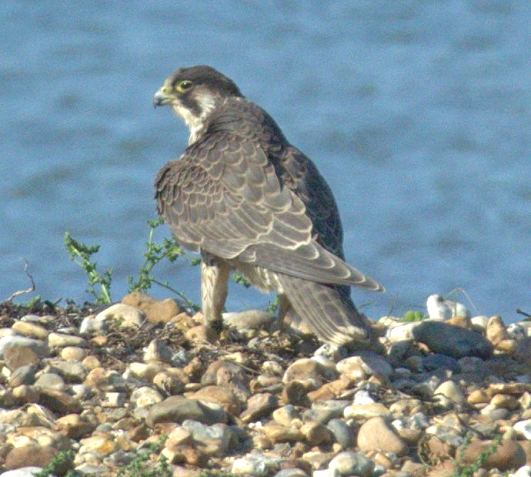
Isle
of Wight Owlet
I have heard
back from Robin Attrill of the Isle of Wight rarities
panel about the Owlet that my son and I saw in
Eaglehead Copse on May 21. Robin confirmed that the
bird is indeed a juvenile Long-eared Owl. He says,
they often leave the nest injudiciously early but
typically make their way back. Long-eared Owl is a
scarce breeding bird on the Island, but the exact
population is not known as it is rather secretive, but
is probably in the order of 10 to 20 pairs. Tawny Owl
is much rarer and is an occasional visitor to the
Island where it is not known to breed, although it is
common in Hampshire.
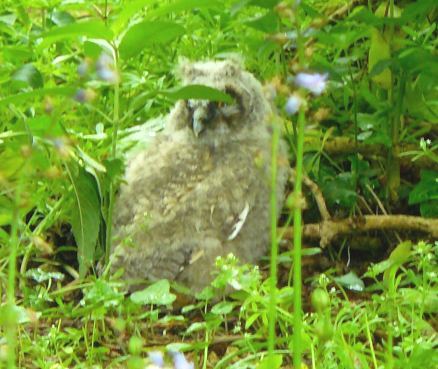
MONDAY
MAY 30 - 2016
Portsdown
Hill
Jean and I
took our two young grand daughters (aged 8 and 10) to
Fort Widley on Portsdown Hill for them to have a good
run around and to see some flowers. They did both,
plus an ice cream at the end to round it off. A very
enjoyable visit, though the wind was pretty brisk on
the north side of the hill. I think we managed to see
most of the regular Portsdown Hill flowers. This is
truly a wonderful area for wild flowers; I forget
sometimes how good it is.
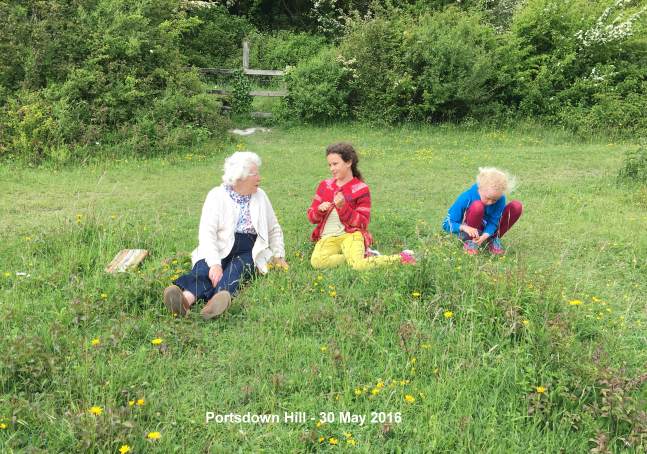
Flowers I noted
included a few Common Spotted Orchids just
starting to open behind the Fort.
The pretty globular flower heads of Salad
Burnet were everywhere - I don't recall having
seen them this abundant before. I think this photo
shows the male flowers with numerous long stamens.
What I assume were
young spikes of Knapweed Broomrape were on the
path below the Fort and Bladder Campion here
and there.
The regular large
patch of Columbines are still present on the
south facing slope - are these native or escapes?
Wild Thyme flourishes on the slope to the west
of the Fort. .. "I know a bank where the wild thyme
blows . . "
Other
news
I saw a single
Swift flying over Bridge Road 11.30 on Sunday
29 May. Only the second sighting so far this year.
I forgot to say I heard my first Cuckoo of the
year in Westbourne while I was looking the Cotton
Thistle at about 9pm on May 28.
Jill Stanley was on
Brook Meadow today and got this nice photo of
Brooklime growing on the edge of the Lumley
Stream on the east side of the meadow. Not a very
common plant on Brook Meadow.
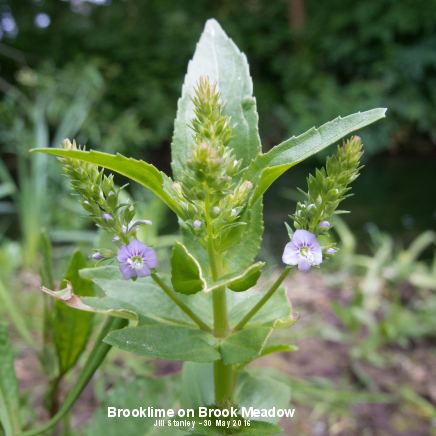
Water
Vole
Carole
Checksfield and Paul Seagrave could not believe their
luck when they had yet another sighting of a Water
Vole in the small pool north of the Lumley footbridge
yesterday. This time the vole was swimming northwards
away from Peter Pond, but Paul managed to get a photo
again.
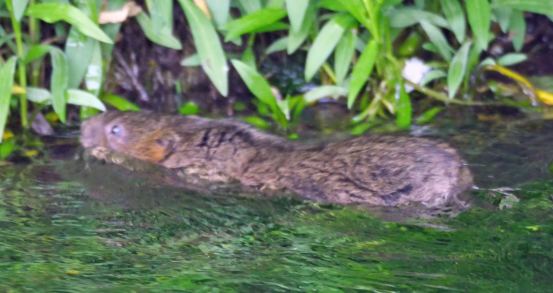
It could be the same
vole that they saw before, but hopefully there is at
least a pair in the area which will breed. Carole
lives 2 mins from Brook Meadow and says they walk
through there most days on our way out walking and
will keep a look out for more. Frustratingly, Jean and
I took two of our grand daughters over there yesterday
hoping to catch sight of the vole. We waited for about
10 mins, but we were out of luck.
See
special web page of the Brook Meadow Water Voles with
full records and photos
http://www.brook-meadow.hampshire.org.uk/bm-water-voles-2016.html
Night
visitors
John Williams,
my neighbour from across the road, gave me a set of
photos including Hedgehog, Fox and domestic Cat that
he caught on a night camera in his back garden last
night. It is amazing what must come through our
gardens at night, quite unseen.
Garden
Blackcaps
Blackcaps are
relatively common in gardens in winter, but far less
common in summer. However, I had a phone call from Pam
Phillips this afternoon to say there are Blackcaps
nesting in the Pittisporum bush in her back garden.
She has seen the male going back and forth and heard
the chirruping of youngsters in the nest. She was
thinking about pruning the bush, but will leave it
until the birds fledge. Blackcaps nesting in gardens
is quite unusual, but certainly not unknown and with
Brook Meadow just a stone's throw away it is hardly
surprising that a pair might set up there.
Stansted
news
Michael Prior,
the forestry manager at Stansted Forest, writes about
the importance of decaying wood habitat in the current
newsletter of the Friends of Stansted. Michael points
out that the phrase 'deadwood habitat' is not correct
as decaying wood is far from dead due to the amount of
life it sustains. He goes on to describe the programme
of retention of decaying wood on the Stansted estate.
They already have a no burn policy in the forest, so
all lop and top is left to decay on the woodland floor
or in heaps. Larger pieces that take along time to
decay are especially important for insects and fungi.
I think everyone who knows and loves the Stansted
estate appreciates the great work that Michael does in
promoting wildlife, as well as maintaining the
woodland as a commercial concern. We owe him large
debt of gratitude.
Michael added that there have been recent sightings of
Hawfinch and Lesser Spotted Woodpecker and he hopes
they may return as breeding birds one day.
SUNDAY
MAY 29 - 2016
A
lovely leaf
I always look
forward to seeing the first leaves of Wall Lettuce
coming up underneath the Beech hedge in Bridge Road.
The plant is not yet in flower, but its leaves must
surely be one of the most interesting and beautiful of
all leaves. Let's hope the dreaded pesticide sprayers
do not come along to zap it as they often do.
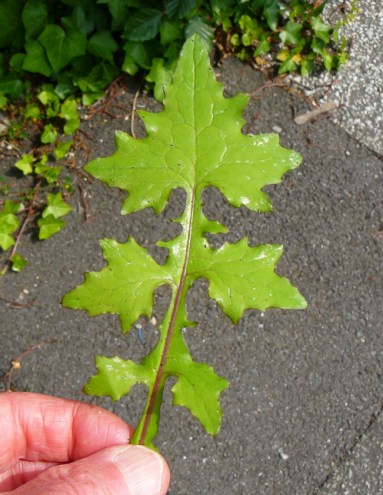
Talking about
pesticides - please go along to the talk at the
Wheelwright's Arms in Havant on Tuesday May 31st at
7pm to support the local campaign to stop this
dreadful and unecological practice.
A
dramatic moth
I spotted this
very attractive moth on some vegetation while I was
doing a quick survey of the Bridge Road Wayside. I did
not know what to make of it, but John Arnott came to
the rescue with a micro-moth called Common
Tubic (Alabonia geoffrella). What a
fabulous animal, says John and I agree.
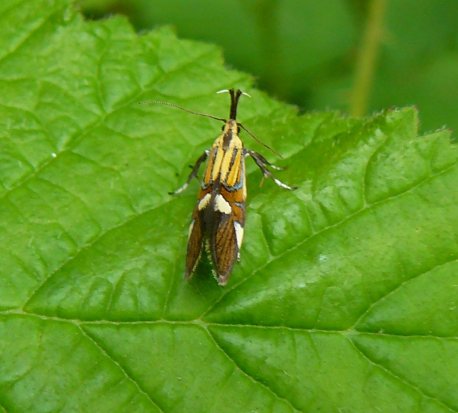
A quick search on
Google will bring up confirmatory photos and
information about it. UK Moths describes it as . . . "
A spectacular day-flying species, with its combination
of rufous, white and metallic blue markings and
remarkably large labial palps. It occurs reasonably
commonly in England and Wales, inhabiting woodland and
marshy places, and flies during May and
June."
Green
Alkanet
John Arnott
also provided some useful extra information about the
plant Green Alkanet which has been recently discussed
on this blog. He says . . . "Alkanet is a diminutive
of the Spanish 'alcanna', which in turn comes from
'al-henna' which is Arabic for the henna plant. The
henna plant is a small tree Lawsonia inermis, which
was used by women in ancient Egypt to redden their
finger and toe nails.

Alkanet (Alkanna
tinctoria) was imported for its red dye from
France and Germany for various uses, e.g. tinting
inferior port, tinting ointments, colouring alcohol in
thermometers, colouring the large decorative bottles
displayed in chemist's shop windows in times past,
staining cabinet-maker's wood and dying hair.
Evergreen Alkanet (or just Green Alkanet) -
Pentaglottis sempervirens may have been
a cheap mediaeval substitute for Alkanet. It was
introduced into this country in the Middle Ages
because its roots also give a red dye. It is native to
the west coast of France, the Iberian peninsula and
the western Mediterranean. Pentaglottis derives from
the Greek for five tongues, referring to the five
white petal pouches at the entrance to the 'throat'
(non-botanical term!) of the flower. Sempervirens is
from the Latin for always green, referring to the
evergreen habit - hence the English name refers to the
evergreen leaves."
Common
Blue Damselfly
My thanks also
to John for correcting my Azure damselfly seen on the
Westbourne Open Space on May 23. The photo is a Common
Blue than an Azure, the tell-tale features are the
stalked black dot on segment 2 of the abdomen (near
the base of the wings), the broad blue shoulder
stripes on the thorax, which are wider than the black
bars below them, and the all blue abdominal segment 10
(which looks like the last abdominal segment) which
has an irregular black pattern at its trailing edge in
the Azure. I agree entirely. Thanks John.
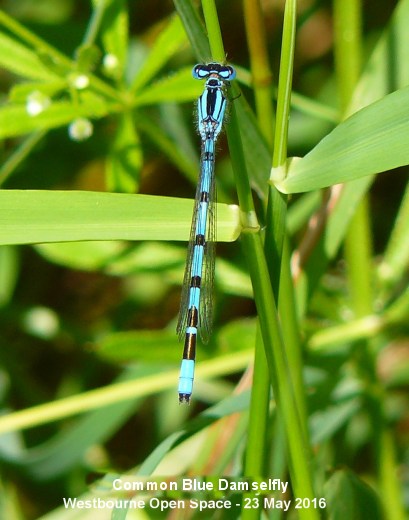
Natural
Curiosities
Chris Oakley
has closed his Hampshire Farm web because of 'lack of
interest' and what he considered as 'the abysmal
mismanagement of the site'. However he has opened a
new nature blog called natural-curiosities.co.uk which
aims to give 'snippets of news from around the
district with a light hearted slant'. Take a look and
if you know of any particularly curious sites let
Chris know . . . http://www.natural-curiosities.co.uk/427995099
SATURDAY
MAY 28 - 2016
Brook
Meadow
I went over to
the meadow this afternoon mainly to check the orchids
and Ragged Robin. I found another couple of
Southern Marsh Orchids in the main orchid area,
taking the total to 6, plus one more on the Lumley
area. They included a double one which we also had
last year. I also found the oval-shaped red Great
Burnet flower buds starting to swell.
I counted the
Ragged Robin which are doing quite well this
year - 154. This is the best count since 2011 when
there were 214 plants in flower. I will do a final
count in a few days time.
Water
Vole!
At last a
Water Vole! Sadly, not on the main River Ems, but on
the Lumley Stream that runs into Peter Pond. Carole
Checksfield sent me the following photo of a Water
Vole on the small pool to the north of Peter Pond that
Paul Seagrave managed to take today at about 5pm. That
is brilliant. We had two earlier sightings of a Water
Vole swimming in what we call the Lumley pool on May 8
and May 9, but this is our first photographic
confirmation. There is no doubt about the
identification, blunt nose small ears, etc. From small
beginnings so they say!
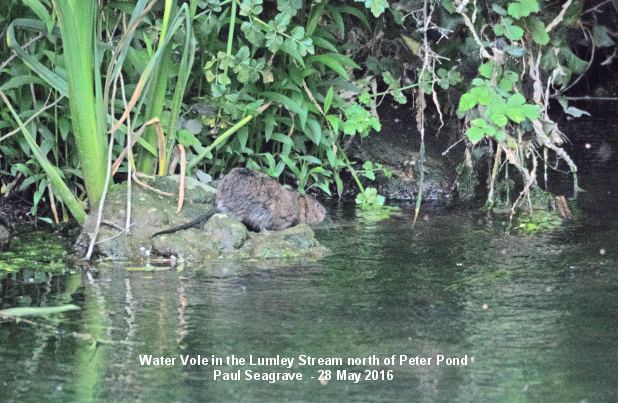
Westbourne
Cotton Thistles
Chris Oakley
came across a splendid crop of Cotton Thistles
immediately behind the new Wellness Clinic (the old
Salvation Army hut) on the right hand side as you go
into Westbourne from Emsworth. Chris adds that this
small patch of land was cleared of brambles, nettles,
etc, last year by the people who opened the Wellness
clinic, but he is not sure who owns the land. Here is
Chris's photo of the plants which are not yet in
flower. They are called Cotton Thistle from the very
soft 'cottony' feel of their leaves, though they still
have sharp spines around the edges.
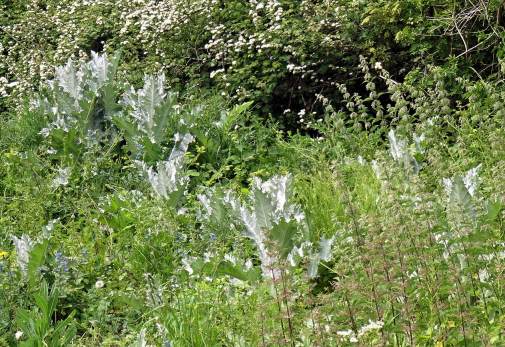
I was interested in
Chris's observation since there used to be some fine
specimens of Cotton Thistles growing on the opposite
side of the road from where the Wellness Clinic is now
sited for many years. They were quite a feature, not
to be found elsewhere locally, but sadly they were
removed a few years ago and replaced by an ugly Laurel
of some sort. Here is my last photo of this verge
taken 5 years ago in June 2011 when it was rich in
semi-wild plants, including not only Cotton Thistles,
but also Fennel and Artichoke.
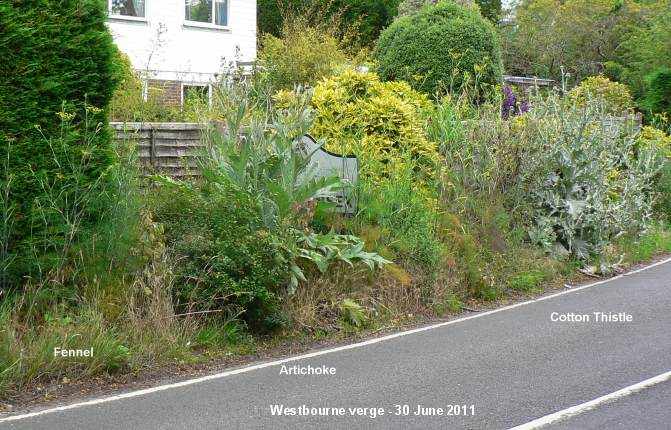
Following Chris's
e-mail, I went to see what the verge looked like
currently. As you can see from the photo below it is a
poor substitute for the rich variety of plants that
used to grow there. Interestingly, the Artichoke
appears to have survived the clearance near the road
sign. At least one can see the Welcome to West Sussex
sign!

FRIDAY
MAY 27 - 2016
Mayflies
While walking
along a stream with friends recently Romney and Ken
Turner enjoyed watching the Mayflies dancing in the
evening sun. Romney tried to capture them in mid air
but not very successful. But was so pleased when she
spotted this one had come down into the grass for a
rest. Look at that tail! From its spotted wings this
one looks like Ephemera danica.
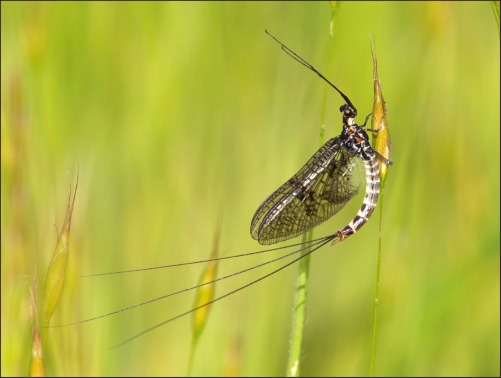
Garden
Jay
Frank Naylor
had a splendid Jay turn up in his garden in Markway
Close, Emsworth yesterday. Jays are quite unusual
garden birds away from woodland. I have only had one
once in my Emsworth town garden in May 2012. In the
BTO Garden BirdWatch scheme Jay is ranked 25th at this
time of the year having been recorded in 11% of
gardens.
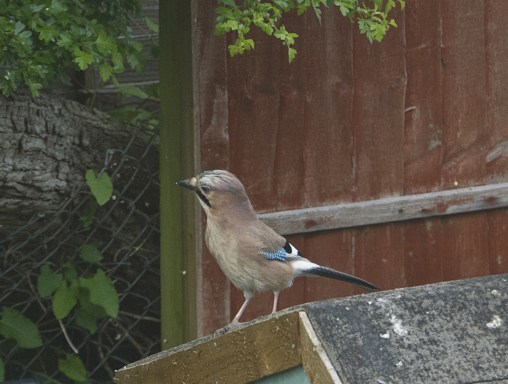
THURSDAY
MAY 26 - 2016
Brook
Meadow
I found four
Southern Marsh Orchids on the main orchid area
on the north meadow, not clustered together like last
year's, but well scattered over the area. Roughly
around Grid Ref: SU 7506 0614. There was another one
on the Lumley area in the same place as last year at
Grid Ref: SU 75136 06031. I have marked them all with
sticks. Here is a photo of the first one to open which
is now starting to look more like an orchid!
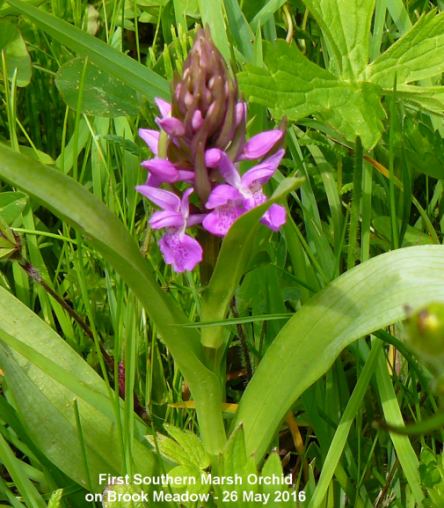
Maurice Lillie also
found some emerging Southern Marsh Orchids. I did not
see his sticks, so maybe they were different ones from
mine? They will be easier to see when they come up
properly. Hard Rush is showing the first spikelets on
the main orchid area.
Mint
Moth
Every year
without fail we see these tiny but very colourful
moths fluttering around the garden. We had one today
which rested long enough for me to get a photo.
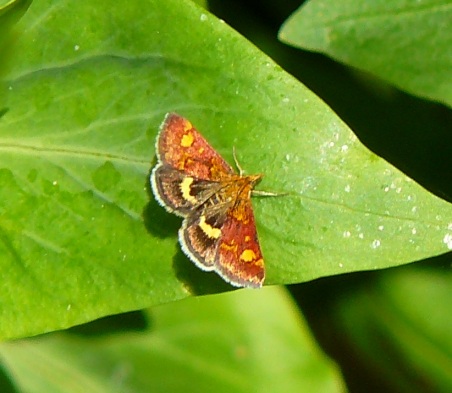
Their scientific name
is Pyrausta aurata but they are often
referred to as mint moths for their liking for mint or
thyme. Mint Moth has two generations, from mid-April
to June and again from July to Sept. Today's moth is
from the first generation.
Ralph's
comments
Ralph Hollins
thought last night's blog was very interesting and
made the following comments:
"Green Alkanet seems to have increased greatly
this year and I see that some people are now thinking
of it as spreading out of control both in this country
and in the USA - see http://www.nwcb.wa.gov/detail.asp?weed=191
One of its uses is as a dye and I wondered if it was
called Green Alkanet because the dye was green but
that is not so - it is blue.
The Periwinkles you photographed at Lumley Mill
are Vinca major var Oxyloba. They are
numerous in the hedge all round the Havant Health
Centre building and at the east end of Daw Lane on
Hayling. Intermediate Periwinkle is said to have very
pale, almost white flowers and I have seen plants
answering that description planted in gardens but have
not come across it in the wild."
Orchids
at Chappetts
Tony Wootton
went to Chappetts Copse where by chance the Hampshire
Wildlife Trust were carrying out the annual orchid
count. Narrow-leaved Helleborine (over 4500) and White
Helleborines together with Fly Orchids and Bird's Nest
Orchids. Very pleasant hour in the warm dappled
sunshine. There is no mistaking the Fly Orchid on the
left, but the Bird's Nest Orchid on the right needs a
bit of working out.
WEDNESDAY
MAY 25 - 2016
Lumley
Wallflowers
Ralph Hollins
was in Emsworth yesterday to look for the first
flowering Southern Marsh Orchid on Brook
Meadow, but failed to find it. It is not very obvious,
but can be seen on the east side of the main orchid
area close to some Osiers. Jill Stanley has marked it
with a small stick. The orchids will be much easier to
see when they are in full flower later in a week or
two.
Of more immediate
interest, Ralph went up Lumley Road past Lumley Mill
and found the yellow flowered Wallflowers
growing on the tall brick wall just before reaching
Lumley Mill Farm. He says "I wondered, as I have done
each year, about the origin of these plants. I have
seen similar plants growing on the walls of
Portchester Castle and looking as if they have been
there since Roman times (you can see them in a photo
taken by Sarah Patton at Wallflowers on Portchester
Castle). The nearest I can get to the origin of this
species Erysimum cheiri is that
Wikipedia says they are native to Europe but Stace
tells me that they are introduced to Britain.... which
would allow for the Romans having brought them
here??"
I had a look at them
myself this morning. The flowers growing on the old
brick wall are, in fact, as mixture of yellow and red.
Some flowers are growing on the ground at the base of
the wall. As Ralph says, they have been there for many
years though clearly not as long as the ones on the
walls of Portchester Castle. However, they are fully
naturalised in that habitat and in that sense are
'wild', though they may well have originated from a
garden escape.
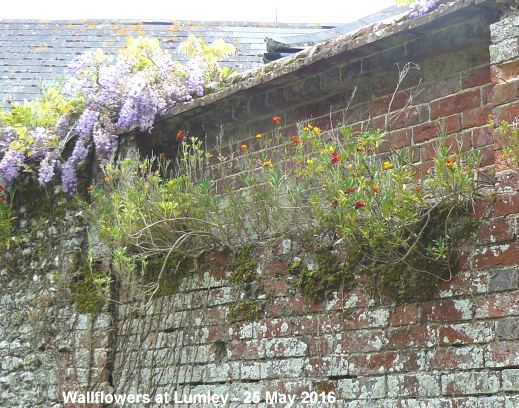
Greater
Celandine
On the way to
see the Wallflowers I stopped to admire the Greater
Celandines with delicate yellow flowers, which
continue to hang on at the end of the path leading
from Seagull Lane to Lumley Mill, despite attempts
over the years by the council and others to get rid of
the 'weeds' along this path.
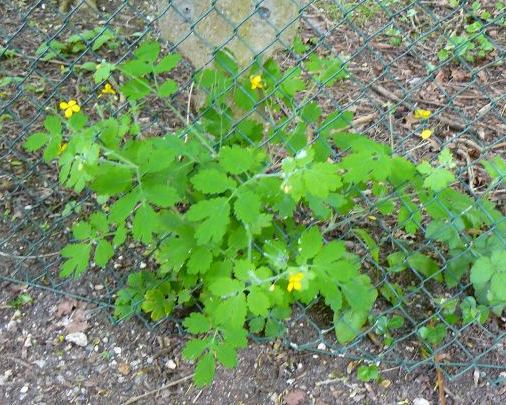
Greater
Periwinkle
On the way
back down to Lumley Road I stopped to look at the
cluster of Greater Periwinkles growing on the
side of the track leading to Lumley Mill. They can be
identified as Greater Periwinkle (as opposed to Lesser
Periwinkle) by the tiny hairs along the leaf margins,
which can just be seen on the photo, but which are
very clear on the plants themselves. I know there is
also a Intermediate Periwinkle though I have never
been sure what that is.
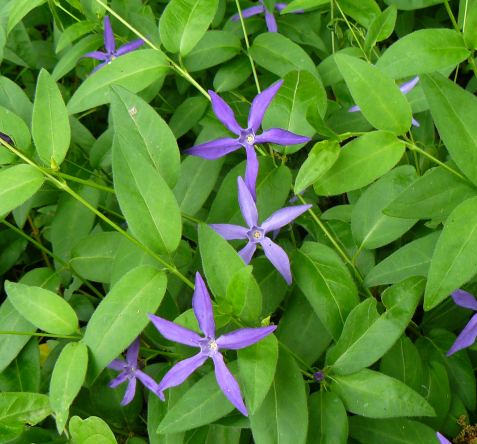
Wood
Sedge
Moving further
down Lumley Road, past the cottages, I came across a
couple of tufts of Wood Sedge on the roadside
adjacent to the Lumley Stream. As this verge is
officially part of the Brook Meadow site I can put
them down as a first for the reserve. This takes the
total number of sedges recorded on the reserve to 14
of which I have found 11 so far this year. These Wood
Sedges were almost certainly not planted there, and
are in an appropriate wooded habitat, so I would
expect them to survive and join the thriving wild
colony of Grey Sedges along this roadside. Remote
Sedge used to grow on the streamside, though I have
not been able to check it out this year.
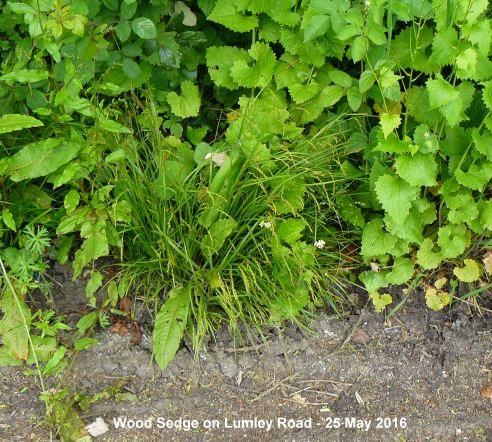
See web site for
complete list of sedges and other plants recorded on
Brook Meadow . . . http://www.brook-meadow.hampshire.org.uk/bm-list-plants.html
Hairy
Buttercups
I entered the
Brook Meadow site itself through the Lumley gate and
made my way down the narrow path on the east side of
the south meadow. This used to be the 'Bramble path',
though the Bramble hedge has now gone as a result of
the flood defence work around the garden of Gooseberry
Cottage. However, the input of fresh soil had created
a real wonderland of plants.
I have already mentioned the magnificent display of
Celery-leaved Buttercups at the southern end of the
path, but today I was confronted with even more
buttercup plants with open flowers and reflexed
sepals. Could they be Hairy Buttercups?
Here
is one of them
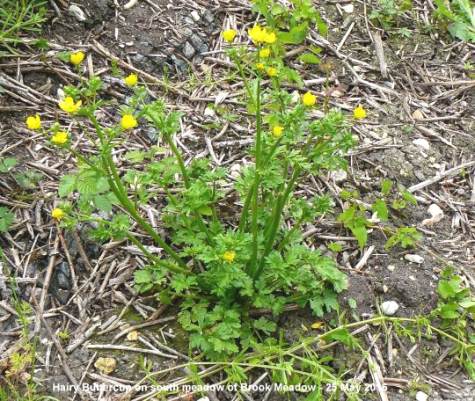
There was only one was
to answer this question, to pull one up. Hey presto!
The plant had roots and no bulbs, which definitely
ruled out Bulbous Buttercups and established them in
my eyes as Hairy Buttercups.
Roots
of the Hairy Buttercup (left) and the reflexed sepals
(right).
I thought this
sacrifice was justified to establish the plant's
identity. Also, there were at least two dozen others
in splendid health. I took the sacrificial plant home
and put it in a pot with compost. If it survives I
will replace it. As Hairy Buttercup is an annual
plant, then there seems a good chance that the present
abundance of plants should yield a good harvest of
seeds for next year. This was the first Hairy
Buttercup recorded on Brook Meadow since July 2012.
Prickly
Sow-thistle
Another plant
thriving on the new soil flood defence embankment is
Prickly Sow-thistle with some magnificent
examples all showing the distinctive rounded auricles
of its basal leaves where they clasp the stem. In
contrast, the leaves of Smooth Sow-thistle clasp the
stem with pointed auricles.
Prickly
Sow-thistle
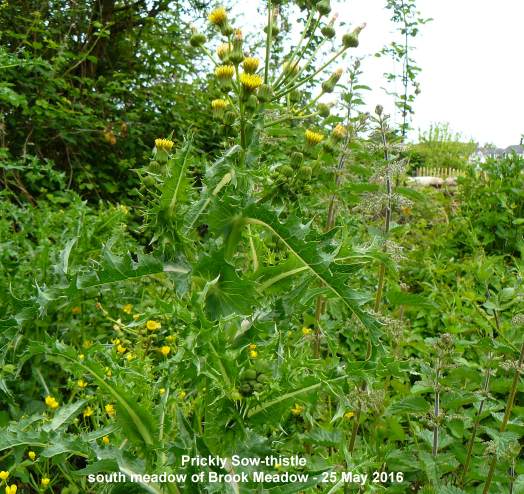
Rounded
auricle of Prickly
Sow-thistle
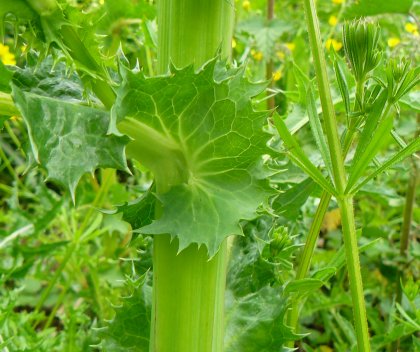
This
shows my bike on the south meadow path
with Celery-leaved Buttercups, Hairy Buttercups and
Prickly Sow-thistles.
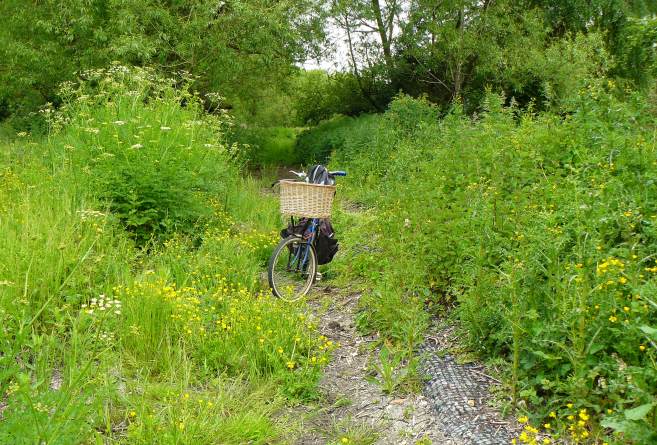
Sea
Club-rush
Further down I
found the first Sea Club-rush of the year on
Brook Meadow flowering in the far south east corner of
the south meadow where there is a saline influence of
tidal waters from Peter Pond.
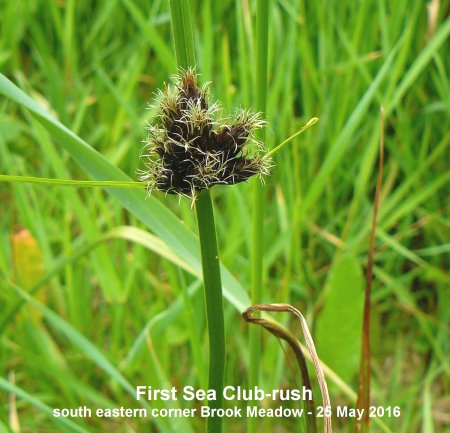
Green
Alkanet
In the
discussion piece on yesterday's blog I mentioned Green
Alkanet as an example of an introduced plant that had
become fully naturalised over a long period of time
and which might therefore be regarded as being 'wild'.
Jill Stanley responded to say that she has been
photographing a splendid specimen of Green Alkanet on
the footpath between Bellevue Lane and Christopher
Way.
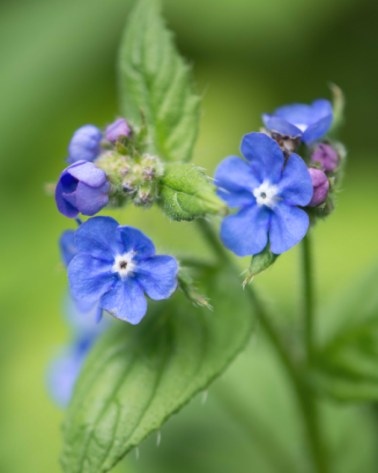
One of her books said
it was 'Introduced to gardens prior to 1700 and
recorded from the wild by 1724' and another book says
it is 'Native in France, naturalised in Britain and
Belgium'. Jill added "it is lovely plant, but
'thuggish' and difficult to eradicate from
gardens!"
I would agree with Jill, though not being a gardener,
I would describe it slightly differently, as a
successful plant which has established itself well in
the community of wild plants. Incidentally, the naming
of this plant has always puzzled me as the flowers are
bright blue and definitely not green.
Grass
Eggar Moth caterpillar
In yesterday's
blog, Maureen Power reported an attractive caterpillar
on Hayling Beach which she was uncertain about. Our
resident caterpillar guru, Mike Wells, came to the
rescue saying . . "I read with interest (as always)
any article on caterpillars and feel that this is a
Grass Eggar Moth caterpillar". Thanks Mike. I gather
dunes are a favoured habitat of this moth.
Maureen's
photo of Grass Eggar
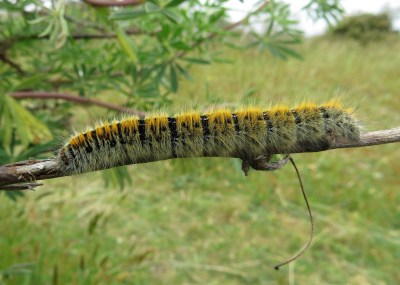
Broad-bodied
Chaser
Graham
Petrie's plans to sort out his hanging basket were put
on hold due to this female Broad-bodied Chaser
dragonfly that had just managed to shed its exuvia
shell. Graham said it was quite a distance from the
pond, and at the top of an 8-foot post, so was
certainly putting in the effort!
Hedgehogs
Regarding the
injured Hedgehog that she found in her garden,
Elaine Morgan added that she took it to the
Downland veterinary surgery on the Havant Road. They
were excellent, but as the injury was so bad they
decided to put the hedgehog to sleep. There was no
charge and one of the assistants told Elaine that they
have a lady who looks after injured hedgehogs and
where possible re-homes them. Always useful to know
these things.
Caroline French says she has had at least one
hedgehog coming to the garden feeding station in
recent weeks. "A couple of days ago a neighbour came
to me and said they had found a hedgehog locked in
their garage for a day (possibly two). They had
already put it in a box so I took it and offered a
plate of mealworms and water. It ate the lot and had
seconds. It appeared to be fine so I placed it in one
of the hedgehog boxes on my garden as a quiet and safe
place for it until nightfall. That night there was a
male and a female in my garden with courtship (bit of
a euphemism) going on. I'll let you know if there are
further developments."
Graham Petrie tells me he has at least one hog
visiting regularly at the moment. He has caught it on
camera once but needs to start putting it out more. We
look forward to more news about Graham's hog.
If there are any other Hedgehog stories please let me
know.
Inholmes
Orchids
This morning
Maureen Power went for a walk in Inholmes wood, above
Stoughton, and found the Fly orchid - in the same
place as described by Di Ashe on June 7th last year.
Also, Twayblades a bit further on and a Greater
Butterfly orchid quite a way further along the same
path.
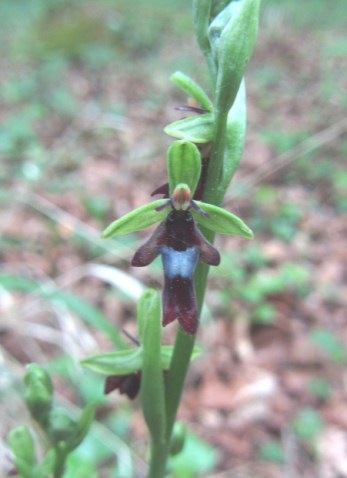
TUESDAY
MAY 24 - 2016
BROOK
MEADOW
Southern Marsh Orchids
I had a look at
the first Southern Marsh Orchid flower spike that Jill
Stanley found on Brook Meadow yesterday. It is in the
usual area on the east side of the main orchid area at
Grid Ref: SU 750061. There was no change from Jill's
photo, so I did not take another. I could not see any
others. Here is the pic that Jill took.
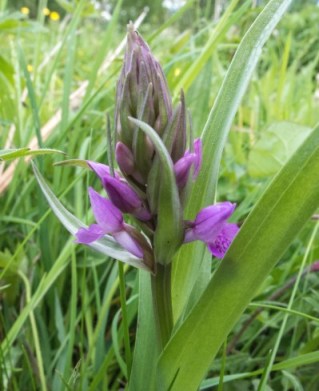
Last year the first
flowering spikes were open on May 18th and by the end
we had a total of 20 plants in flower (including 3 on
the Lumley area) which is a record for the meadow. The
first two Southern Marsh Orchids were donated by Nigel
Johnson who had grown them in pots from originals
collected from the large colony on South Moor at
Langstone. They were planted on Brook Meadow in June
2005, so, in 10 years they have multiplied 10 times
and at this rate we should have 200 in year 2025. That
sounds good, though I am unlikely to be around to see
them.
Slender
Spike-rush
I managed to
find the patch of Slender Spike-rush (Eleocharis
uniglumis) in the same location in the centre
of the Lumley area, where John Norton first discovered
it on the on June 4, 2012. Here it is in comparison
with Common Spike-rush which grows nearby. The Slender
Spike-rush is on the left and, as one would expect, is
slenderer than the Common Spike-rush on the right.
Apart from differences in size, Slender only has the
lowest glume of the spikelet without a floret; in
Common both the two lowest glumes are empty. Martin
Rand says the Slender Spike-rush is widespread albeit
rather localised in Britain.
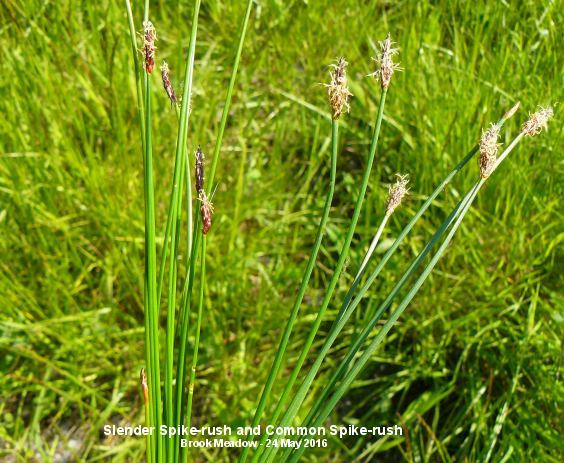
Other
plants
Other firsts
for 2016 on Brook Meadow included Cut-leaved
Crane's-bill and Yellow Rattle - the first
I have seen anywhere.
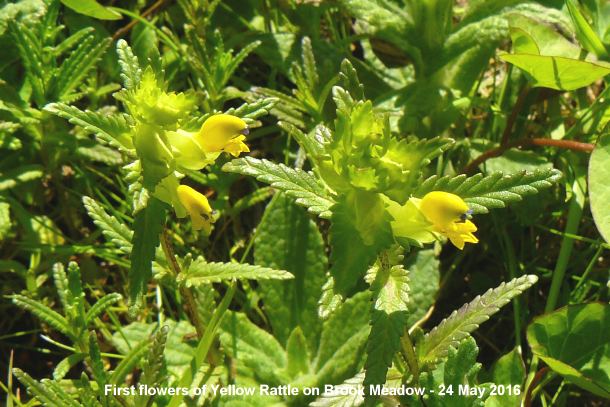
The first flower buds
are now showing on the Great Burnet in the
centre of the orchid area. Many of the common grasses
are now in flower including Meadow Foxtail, Marsh
Foxtail, Cocksfoot, Barren Brome, Soft Brome, Tall
Fescue, Red Fescue, False Oat-grass and Yorkshire Fog.
Insects
Two
observations of interest on the meadow were a pair of
22-spot Ladybirds mating and a
Froghopper. The very distinctive red and black
Froghopper gets its name from its ability to jump. It
also produces masses of froth in which the nymphs
develop and this gives rise to other names such as
spittle-bugs and Cuckoo-spit insects.
SLIPPER
MILLPOND
I could see
just two Great Black-backed Gull chicks on the
centre raft with their parents. Both were moving
around, but there was no sign of the third that Mike
Wells got on camera on May 20. I fear one could have
been lost.
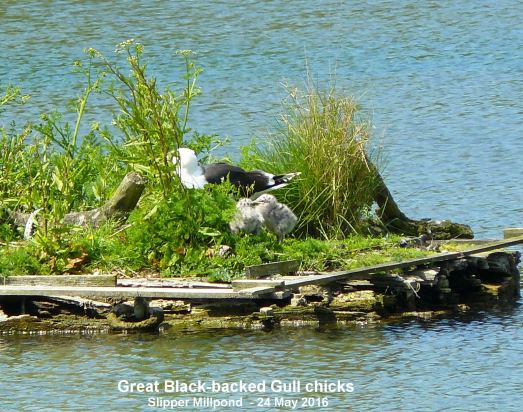
Mute Swan
family was on Dolphin Lake with 4 cygnets still
intact.
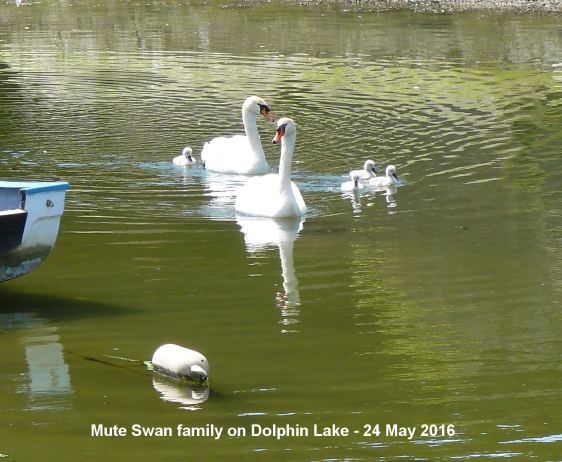
ISLE
OF WIGHT OWLET
I was pleased
to get an e-mail from Fiona McKinnon about the young
Owl that my son Pete and I saw in Eaglehead Copse on
the Isle of Wight last Saturday. Fiona pointed out
that my photo of the bird showed prominent "ear tufts"
and yellow eyes, both of which are characteristic of a
Long-eared Owl and not a Tawny Owl which is what I
called it. I must admit I just assumed it was a Tawny
Owl as the woodland habitat was right without really
looking too closely at the photo. Here it is again.
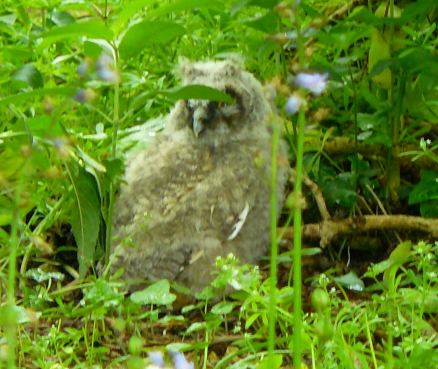
I have subsequently
learned that Tawny Owls are quite rare birds on the
Isle of Wight with very few sightings, though
Long-eared Owls are more common and there are breeding
records for them. On my son's suggestion, I have sent
the sighting and photo to the Isle of Wight rarities
panel for their interest.
Caterpillars
Maureen Power
went down to Hayling last week (20th) and saw lots of
the Green-winged Orchids, also Thrift, Sea Campion,
Yellow Rattle, Sea Kale, Lupins, etc. She found these
caterpillars on a couple of Lupin plants and wondered
if I knew what they were. The nearest pictures she
could find seemed to be the Oak Eggar moth. Any other
offers?
Wild
or escapes - Discussion point
This question
comes up again and again. When is a plant wild even if
it is a garden escape? I think if it is growing in a
location of its own accord (i.e. it was not planted
there by someone) then it is definitely wild. It might
not last very long in which case it is often referred
to as a 'casual'. Its garden origin doesn't alter
that. For example Green Alkanet is not native, but it
is widely 'naturalised' which means that it is not
native, but has successfully managed to reproduce
itself in the wild.
MONDAY
23 MAY - 2016
Waysides
News
I met up with
Jane Brook this morning for a tour around some of the
Emsworth waysides; Greville Green (west), Spencer's
Field verge (adjacent to Horndean Road) and the
Westbourne Open Space. The grasses on all three sites
were burgeoning and looking good. Generally, the
Spencer's Field wayside was the most interesting. Here
a few of the highlights.
Cut-leaved
Crane's-bill - generally in flower on all
waysides
False Oat-grass - my first of the year on the
Spencer's Field.
Azure
Damselflies - at least 4 on different waysides
CORRECTION
- the damselfly in the photo is Common
Blue (see blog
entry May 29)
Crab Spider - possibly Misumena
vatia - resting a panicle of Cocksfoot.
Shield Bugs - Dock
Leaf bug
Sloe bug - both on the Spencer's Field
wayside.
Nursery-web
spider (Pisaura mirabilis) - on Spencer's
Field
Spiderlings - probably Garden Spiders - in a
nest.
Millpond
news
The Great
Black-backed Gulls were present on the centre raft
when I visited this afternoon and I could just see two
chicks. Three chicks were seen last week by Mike
Wells, but the vegetation on the raft is so dense that
the other one could easily have been hidden.
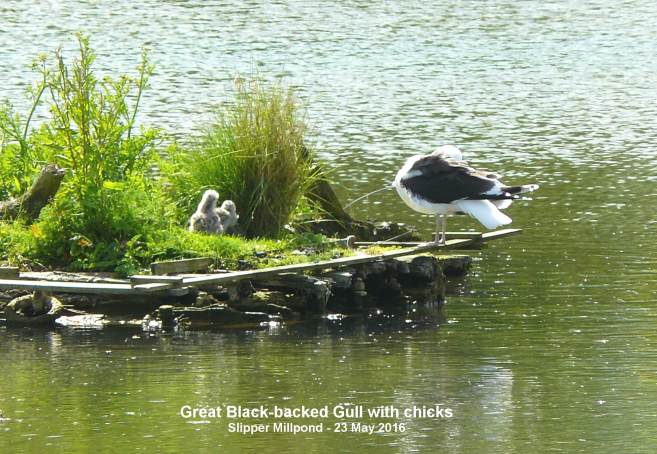
The Mute Swan
family is down to 4 cygnets from the 5 that were
hatched on May 9th. The pen was with the cygnets on
Peter Pond. The cob standing guard on the east bank -
hissing fiercely if I came too close. A little later I
saw the whole family on Slipper Millpond, though
keeping well clear of the gulls on the raft. Here is
mum with the babies on Peter Pond
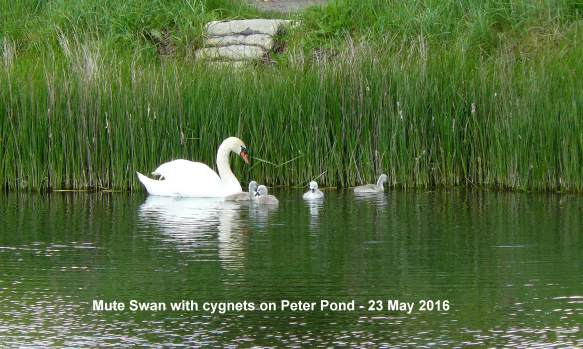
Brook
Meadow
I was
encouraged to see an increase in flowering Ragged
Robin plants on the Lumley area since I last
checked them on May 16. Today, I counted a total of 67
plants in flower which is a big increase on last
year's final total of 34, though still some way behind
the 2014 total of 104. But there is still time.
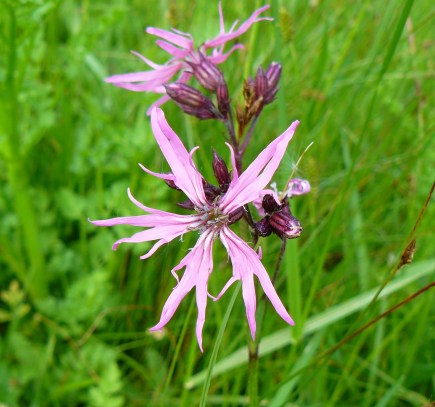
Jill Stanley was also
on Brook Meadow this afternoon and was pleased to find
the first of the emerging Southern Marsh
Orchids. These are the first of our orchids to
flower, but the others should be following in a week
or so. This first flower was a bit later than last
year, but generally about right on average. Jill also
spotted a nice little patch of Lesser
Stitchwort about 50 yards to the east of the main
seat, in the same place that she saw them last year.
Hedgehog
news
My request for
sightings of Hedgehog in the last Brook Meadow e-mail
Newsletter brought the following three replies:
Irene Selway has a
hedgehog that comes to her garden at night. "He/she is
fairly big but one year there was a baby one. I don't
know if they live under my shed/summer house deck but
they visit every year. They don't hang about because
if the dogs see them they bark and then they roll up
and sit out the danger till I get the dogs indoors.
Nevertheless they still visit each year for a while at
this time of year."
Elaine Morgan has also
seen Hedgehogs in her garden over the years. "This
year so far I have seen only one, and sadly I had to
take it to the vet to be put to sleep. It was in my
hedge couple or three weeks ago in a warm sunny spot
and was not moving much, which didn't seem quite
right. I picked it up and examined it and one of its
back paws was missing and there was no flesh on the
leg, just the bone. I did wonder whether it had been
caught in a mouse/rat trap."
Tim and Elaine Abel
live in Brook Gardens and have a small hedgehog
visiting every night to feed on dried mealworms. Tim
also sees a bat that flies over and says they have had
bats continually for the whole 33 years they have
lived there.
Pesticide
Action meeting
Ray Cobbett
reports: "The next group meeting is on Tuesday 31 May
at The Wheelwrights Arms in Havant when we welcome
Nick Mole, Policy Officer for Pesticide Action
Network, a National charity, campaigning for banning
harmful pesticides from public places in our cities
and towns. This includes the use of neonics which are
thought to be partly responsible for Colony Collapse
Disorder among Honey Bees and other pollinators. The
meeting starts at 7 pm it's free and open to all who
share our concerns."
WILDLIFE
NEWS UPDATE
May 17 to May 22
News
from the Isle of Wight
Jean and I
spent a few days on the Isle of Wight staying with our
son, Peter, and his family at Cowes. The weather was
rather mixed and I did not have much opportunity for
wildlife watching. However, Peter was able to take me
to see a couple of interesting things that I had not
seen before.
The first was my first ever Greater Butterfly
Orchids in Walters Copse near to the Newtown
Nature Reserve. Six of them were in flower in the
copse. Greater Butterfly Orchid is a rare flower,
listed as 'Near Threatened'. It is sparsely
distributed on the Isle of Wight. The photo on the
left shows a spike of flowers, not fully open. The
photo on the right shows an open flower with the
distinctive long spur.
Although they were
well past their best I was pleased Peter was able to
take me to Eaglehead Copse near Sandown to see
Toothwort. There were still a lot of spikes on
show in the woods, we saw at least 100. This was one
of the best.
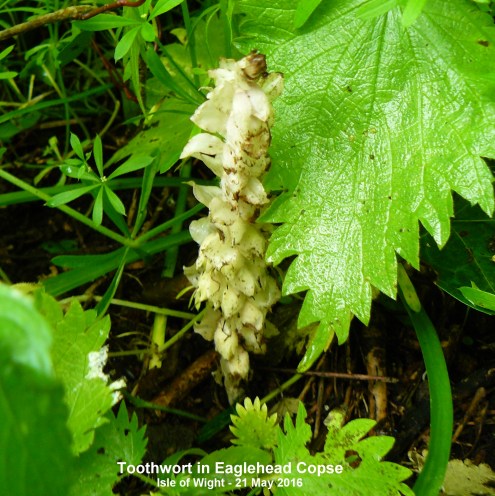
While walking through
Eaglehead Copse my son spotted a young Tawny
Owl on the ground, looking quite well and healthy.
We were a little concerned for its safety, but were
reassured by a wildlife expert that the youngster will
almost certainly be able to climb back up the tree.
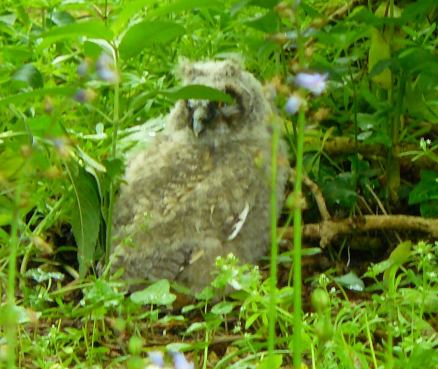
Jean and I paid a
visit to Ventnor Botanical Gardens where it was good
to see the Wall Lizards were still present in
the despite the change in ownership.
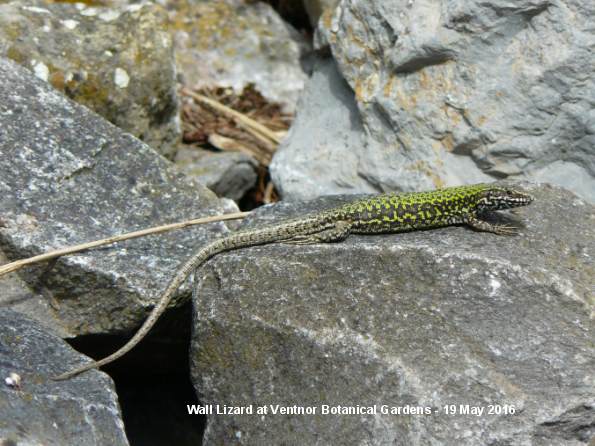
Local
wildlife news
Slipper
Millpond
The big news while I was away was the hatching of
three Great Black-backed Gull chicks on the centre
raft on Slipper Millpond. I am grateful to Mike Wells
for sending me a nice photo of the chicks. I hope they
are still there!
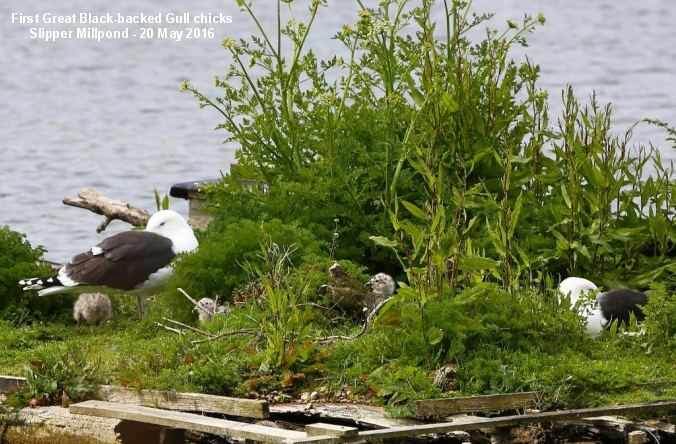
Emsworth
Millpond
22 May - Chris
Oakley sent the following picture of a Mallard duck
and her eleven ducklings on the Emsworth millpond. I
wonder how long they will survive?
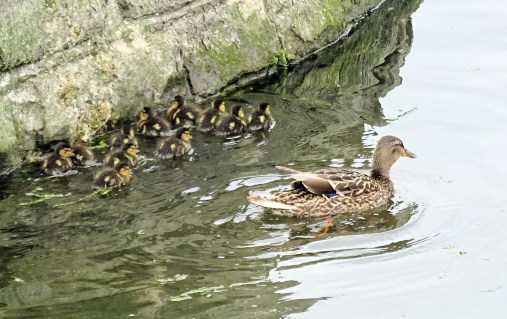
Baffins
Pond
22 May - Eric
Eddles reports that only one Barnacle Goose chick
survived on Baffins Pond.
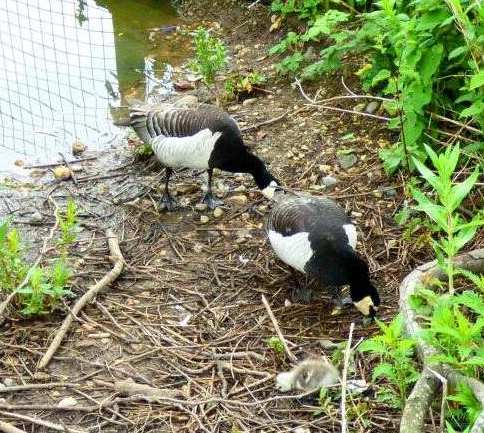
Langstone
Mill Pond
May 17 - Peter
Milinets-Raby popped down to Langstone Mill Pond,
walking in from Wade Lane 12:38pm to 1:41pm - low
tide. Wade Lane: Chiffchaff singing, 4 Stock Dove, 10
Swallows hawking over pony stables, 2 Med Gulls over,
1 Swift over and 1 Buzzard. Dried up horse paddock: 3
Stock Doves and Blackcap heard singing.
Langstone Mill Pond: Rape, orgy, attempted murder?? I
couldn't make up my mind what it was, but it lasted 15
brutal frenzied minutes with the female often
submerged with all the males on top of her trying to
grab her neck. At one point she had 8 male Mallard on
top of her and a Coot. Why the Coot got involved I do
not know? She did manage to fly off. See photo - not
for the squeamish!!
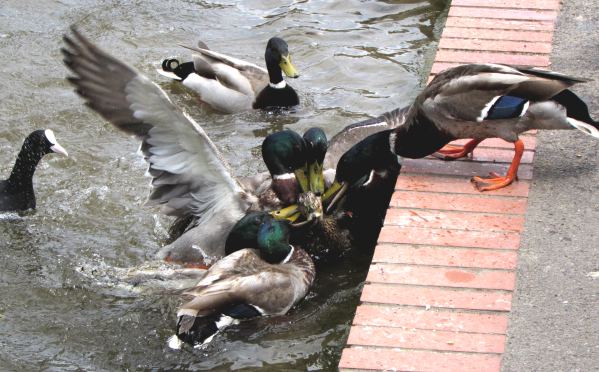
On the pond was a male
Gadwall, 2 Swift over, 2 singing Reed Warblers, and I
noticed three extra Little Egret nests, bringing the
total of nests to 40. A very impressive count. 17 Med
Gulls over and later a flock of 20 circled over before
heading inland!
Checked out the gulls on the roof top of the Colt
factory along New Lane, Havant and counted 5 pairs of
Lesser black-backed Gulls, a sitting Great
Black-backed Gull and at least 22+ Herring Gulls
nests!
Great
Spotted Woodpeckers
May 18 -
Barrie Jay says his resident breeding pair of Greater
Spotted Woodpeckers are very active at this moment,
going backwards and forwards from feeders to their
nest every few minutes. Here is a pic taken last year
of parent and youngster on the feeder.
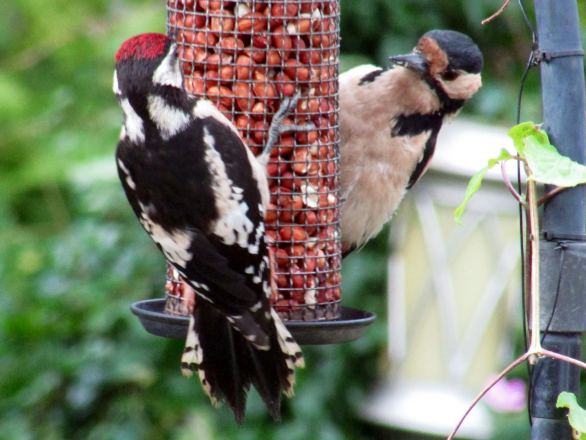
For
earlier observations go to . . May
1-16